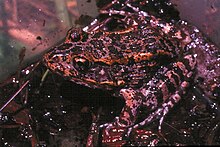Gopher Frog
| Gopher frog | |
|---|---|
 |
|
| Scientific classification | |
| Kingdom: | Animalia |
| Phylum: | Chordata |
| Class: | Amphibia |
| Order: | Anura |
| Family: | Ranidae |
| Genus: | Lithobates |
| Species: | L. capito |
| Binomial name | |
|
Lithobates capito Frost, 2006 |
|
| Synonyms | |
|
Rana capito, LeConte, 1855 |
|
Rana capito, LeConte, 1855
The gopher frog (Lithobates capito) is a species of frog in the Ranidae family, endemic to the Southeastern United States. It primarily inhabits the threatened sandhill communities, flatwoods, and scrub in the Atlantic coastal plain, where it is usually found near ponds.
Its two subspecies include the Carolina gopher frog (L. c. capito), and Florida gopher frog (L. c. aesopus). The dusky gopher frog (L. sevosus) had previously been considered a subspecies, but was elevated to species status in 2001.
Its primary threats include loss of habitat and fire suppression. It is entirely dependent upon small vernal pools for its annual reproduction. These pools in pine flatwoods are being lost to development, and to fire suppression, which allows forests to invade the natural savanna habitat. Hence, prescribed burns and habitat acquisition are considered key management strategies for its survival.
...
Wikipedia

